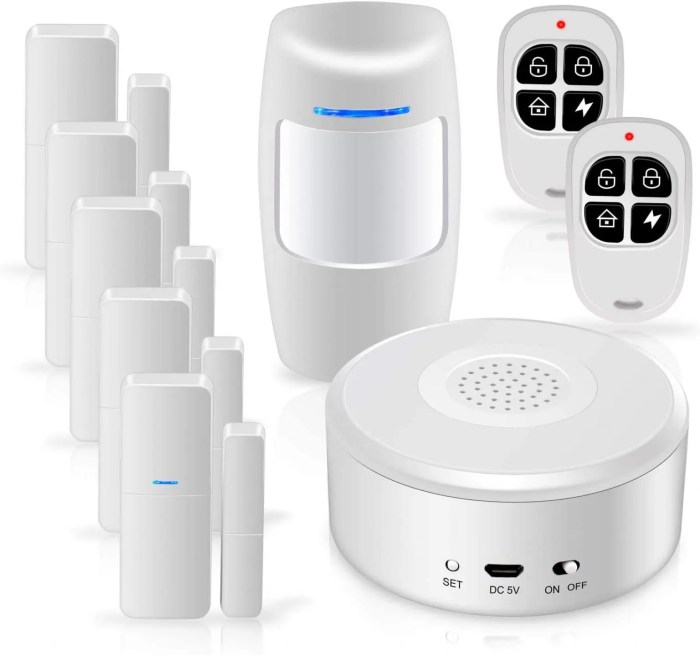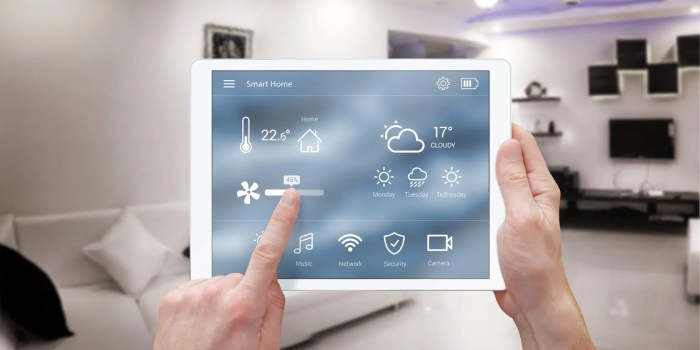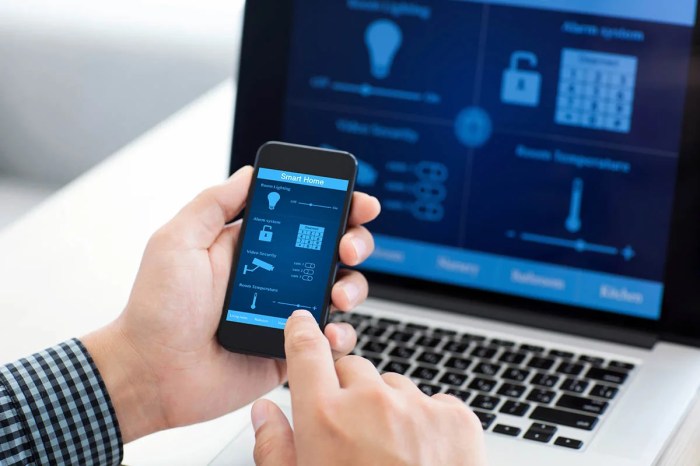In a world where technology pervades every aspect of our lives, the concept of smart homes has captured the imagination of homeowners seeking convenience, energy efficiency, and enhanced security. However, the perceived cost of smart home systems often deters many from embracing this transformative technology.
This article delves into the realm of affordable smart home systems, dispelling the myth that a smart home is a luxury reserved for the affluent.
Unveiling the secrets to building a budget-friendly smart home, we will explore the essential components, compare different systems, and uncover creative cost-saving strategies. Discover how you can transform your ordinary abode into a technologically advanced haven without breaking the bank.
Definition of Cheapest Smart Home System

A smart home system integrates various devices and appliances in your home into a centralized network, allowing you to control and monitor them remotely. It typically includes smart thermostats, lights, door locks, and security cameras, which can be accessed and managed through a smartphone app or voice commands.
Factors Affecting the Cost of a Smart Home System
The cost of a smart home system can vary depending on several factors:
- Number of Devices: The more devices you want to connect to your smart home system, the higher the cost will be.
- Type of Devices: Some smart devices are more expensive than others. For example, a smart thermostat is typically more expensive than a smart light bulb.
- Features: The more features a smart device has, the more expensive it will be. For example, a smart thermostat that can learn your heating and cooling preferences will be more expensive than a basic model.
- Installation Costs: Some smart devices require professional installation, which can add to the overall cost of the system.
Examples of Affordable Smart Home Systems
Despite the potential costs, there are several affordable smart home systems available in the market:
- Google Nest Mini: The Google Nest Mini is a budget-friendly smart speaker that can control various smart home devices. It is priced at around $49.
- Amazon Echo Dot: The Amazon Echo Dot is another affordable smart speaker that can control smart home devices. It is priced at around $49.
- TP-Link Kasa Smart Plug: The TP-Link Kasa Smart Plug allows you to control appliances and electronics remotely. It is priced at around $15.
- Wyze Cam: The Wyze Cam is an affordable security camera that can be used for indoor or outdoor surveillance. It is priced at around $20.
Cost Comparison of Different Smart Home Systems

When choosing a smart home system, cost is a major factor to consider. Different systems offer varying features and components, which can significantly impact the overall price. To help you make an informed decision, we’ve compiled a table comparing the costs of different smart home systems, along with their pros and cons.
System Components and Features
The table below compares the system components and features of different smart home systems. This includes the number of devices supported, the types of devices that can be controlled, and the availability of additional features like voice control and remote access.
| System | Number of Devices Supported | Types of Devices | Voice Control | Remote Access |
|---|---|---|---|---|
| System A | Up to 100 devices | Lights, thermostats, door locks, cameras | Yes | Yes |
| System B | Up to 50 devices | Lights, thermostats, speakers | No | Yes |
| System C | Up to 25 devices | Lights, plugs, sensors | Yes | No |
Pricing
The table below compares the pricing of different smart home systems. This includes the cost of the hub, the cost of individual devices, and any additional fees or subscription costs.
| System | Hub Cost | Device Cost | Additional Fees |
|---|---|---|---|
| System A | $100 | $20-$50 per device | None |
| System B | $50 | $10-$30 per device | $10/month subscription fee |
| System C | $25 | $5-$15 per device | None |
Pros and Cons
Each smart home system has its own pros and cons. Here’s a brief overview:
- System A: Pros: Supports a large number of devices, offers voice control and remote access. Cons: More expensive than other systems.
- System B: Pros: Affordable, easy to set up, offers remote access. Cons: Fewer supported devices, no voice control, subscription fee required.
- System C: Pros: Very affordable, easy to use. Cons: Limited number of supported devices, no voice control or remote access.
Features to Consider When Choosing a Budget-Friendly Smart Home System
When selecting a budget-friendly smart home system, it’s crucial to consider essential features that align with your needs and budget. These features offer convenience, security, and energy efficiency, but each has its own benefits and drawbacks. Understanding these aspects will help you prioritize features and make informed decisions.
Compatibility and Integration
Compatibility and integration are key factors to consider. Ensure the system is compatible with your existing devices and supports popular smart home platforms like Amazon Alexa, Google Assistant, or Apple HomeKit. Seamless integration allows for centralized control and automation across different devices and services.
Security and Privacy
Security and privacy are paramount in smart home systems. Look for systems that employ robust encryption protocols, two-factor authentication, and regular security updates to safeguard your data and protect against cyber threats. Additionally, consider systems that offer customizable privacy settings to control the collection and sharing of personal information.
Ease of Use and Installation
Ease of use and installation are important considerations for a budget-friendly smart home system. Opt for systems that are user-friendly, with intuitive interfaces and simple setup processes. Self-installation options can save on professional installation costs, but ensure the system provides clear instructions and support resources.
Energy Efficiency and Automation
Energy efficiency and automation features can help you save money and reduce your environmental impact. Look for systems that offer smart thermostats, lighting control, and energy monitoring capabilities. Automation features, such as scheduling and geofencing, can further optimize energy usage based on your routines and preferences.
Affordability and Scalability
Affordability is a primary concern when choosing a budget-friendly smart home system. Compare prices of different systems and consider the cost of additional devices and accessories. Scalability is also important if you plan to expand your smart home system in the future.
Choose a system that allows for easy addition of new devices without compromising performance or functionality.
Tips for Prioritizing Features
Prioritizing features depends on your individual needs and budget. Consider the following tips:
- Identify must-have features that are essential for your smart home setup.
- Evaluate the benefits and drawbacks of each feature to determine which ones align best with your lifestyle and preferences.
- Set a budget and stick to it. Prioritize features that offer the most value and functionality within your budget.
- Consider the long-term potential of the system. Choose a system that can grow with your needs and accommodate future expansions.
By carefully considering these features and prioritizing them based on your needs and budget, you can select a budget-friendly smart home system that delivers convenience, security, and energy efficiency without breaking the bank.
DIY vs. Professional Installation
Hiring a professional for smart home installation can cost significantly more than DIY installation. However, professional installation offers several benefits, including guaranteed quality, time savings, and access to specialized expertise. DIY installation, on the other hand, allows for customization, cost savings, and a sense of accomplishment.
DIY Installation
DIY installation requires careful planning, technical skills, and the right tools. Essential tools include a screwdriver, drill, wire strippers, and a voltage tester. Additionally, a basic understanding of electrical wiring and home networking is necessary.
- Pros:
- Cost-effective
- Customization and flexibility
- Sense of accomplishment
- Cons:
- Requires technical skills and knowledge
- Time-consuming
- Potential for errors and safety hazards
Professional Installation
Professional installation typically involves hiring a certified electrician or smart home installer. The cost varies depending on the complexity of the system and the installer’s rates.
- Pros:
- Guaranteed quality and performance
- Time-saving and convenience
- Access to specialized expertise and tools
- Cons:
- Higher cost compared to DIY installation
- Less customization and flexibility
- Reliance on the installer’s availability and schedule
DIY Installation Guide
For DIY installation, follow these steps:
- Research and Planning:
- Choose a compatible smart home system.
- Create a detailed plan for device placement and wiring.
- Obtain necessary permits and approvals, if required.
- Preparation:
- Gather the necessary tools and materials.
- Turn off the power to the area where you’ll be working.
- Wear appropriate safety gear, including gloves and safety glasses.
- Installation:
- Follow the manufacturer’s instructions for each device.
- Connect devices to the power supply and network.
- Test the system to ensure it’s functioning properly.
- Troubleshooting:
- If you encounter issues, refer to the manufacturer’s troubleshooting guide.
- Consider seeking assistance from an experienced friend or family member.
- If the problem persists, contact the manufacturer’s support team.
Cost-Saving Strategies for Building a Smart Home System

Setting up a smart home system doesn’t have to break the bank. With a bit of creativity and planning, you can achieve a smart home without sacrificing quality or functionality. Here are some effective strategies to save money while building your smart home system:
Affordable Alternatives to Expensive Smart Home Devices
There are many affordable alternatives to expensive smart home devices available in the market. For instance, instead of purchasing a high-end smart thermostat, consider a programmable thermostat that offers similar features at a lower cost. Additionally, explore budget-friendly smart plugs, motion sensors, and security cameras that provide basic functionality without compromising quality.
DIY Installation and Setup
If you’re comfortable with basic DIY projects, consider installing and setting up your smart home system yourself. This can save you significant costs compared to hiring a professional installer. However, ensure you thoroughly understand the installation instructions and have the necessary tools and skills to avoid potential issues.
Utilize Open-Source Software and Platforms
Open-source software and platforms like Home Assistant and OpenHAB offer a wide range of features and customization options for your smart home system. These platforms are free to use and can be integrated with various smart home devices, providing you with a cost-effective alternative to proprietary smart home systems.
Look for Sales and Discounts
Keep an eye out for sales and discounts on smart home devices and components. Many retailers offer seasonal sales, Black Friday deals, and clearance events where you can find great deals on smart home products. Additionally, consider purchasing refurbished or used smart home devices from reputable sellers to save even more money.
Prioritize Energy Efficiency
Investing in energy-efficient smart home devices can lead to long-term savings on your energy bills. Look for smart thermostats, smart lighting systems, and smart appliances that are designed to reduce energy consumption and optimize energy usage. These devices may have a higher upfront cost, but they can pay for themselves over time through energy savings.
Smart Home System Maintenance and Troubleshooting

Maintaining your smart home system ensures optimal performance, prevents issues, and extends its lifespan. Regular maintenance includes updating firmware, checking for software updates, and inspecting devices for any physical damage or malfunction.
Common issues that may arise include connectivity problems, device compatibility issues, and automation malfunctions. Troubleshooting these issues typically involves checking network connections, ensuring devices are compatible, and resetting or reconfiguring devices as needed.
Warranty and Support Services
Different smart home system providers offer varying warranty periods and support services. Some common support options include online resources, customer support hotlines, and on-site repair or replacement services. Consider these factors when choosing a smart home system to ensure you have access to adequate support if needed.
Future Trends and Innovations in Smart Home Systems
The realm of smart home systems is continuously evolving, driven by technological advancements that promise to enhance convenience, energy efficiency, and security. These innovations have the potential to reshape the way we interact with our homes and may also impact the cost and accessibility of smart home systems.
Emerging Technologies
Emerging technologies like artificial intelligence (AI), machine learning (ML), and the Internet of Things (IoT) are shaping the future of smart home systems. AI-powered virtual assistants, such as Amazon’s Alexa and Google Assistant, are becoming more sophisticated, enabling natural language interactions and personalized recommendations.
ML algorithms analyze data patterns to optimize energy usage, automate tasks, and enhance security. IoT devices, including smart thermostats, lights, and appliances, connect to a central hub, allowing remote control and monitoring.
Cost and Accessibility
As these technologies advance, the cost of smart home systems is expected to decrease, making them more accessible to a wider range of consumers. The integration of AI and ML algorithms may also improve the efficiency of smart home systems, potentially reducing energy consumption and lowering utility bills.
Additionally, the growing popularity of smart home devices and services is driving competition among manufacturers, leading to more affordable options.
Potential Benefits
The integration of emerging technologies in smart home systems offers numerous potential benefits. AI-powered virtual assistants can provide personalized recommendations, anticipate user needs, and automate routine tasks. ML algorithms can optimize energy usage, detect anomalies, and enhance security by identifying suspicious activities.
IoT devices can automate tasks such as lighting control, thermostat adjustment, and appliance management, saving time and energy.
Challenges
Despite the promising advancements, there are also challenges associated with the integration of emerging technologies in smart home systems. Data privacy and security concerns arise as these systems collect and transmit sensitive information. Additionally, the complexity of these systems may require professional installation and maintenance, potentially increasing the overall cost.
Interoperability issues between different devices and platforms may also hinder seamless integration and functionality.
Summary

The journey towards a smart home doesn’t have to be an expensive endeavor. With careful planning, informed decision-making, and a touch of DIY spirit, you can create a smart home system that seamlessly integrates with your lifestyle and budget. Embrace the possibilities of a connected home, where convenience, efficiency, and security go hand in hand, all without compromising your financial well-being.
FAQ Section
What are the key components of a smart home system?
A smart home system typically consists of smart devices such as lights, thermostats, door locks, and security cameras, all connected to a central hub or controller. These devices can be controlled remotely via a smartphone app or voice commands.
How much does a basic smart home system cost?
The cost of a basic smart home system can vary depending on the brand, features, and number of devices. However, affordable options are available, with starter kits typically ranging from $100 to $300.
Can I install a smart home system myself?
Many smart home systems are designed for DIY installation, making them accessible to homeowners with basic technical skills. However, some systems may require professional installation for more complex setups.
What are some cost-saving strategies for building a smart home?
Consider purchasing refurbished or open-box smart devices, opting for budget-friendly brands, and exploring DIY projects to create your own smart home devices.